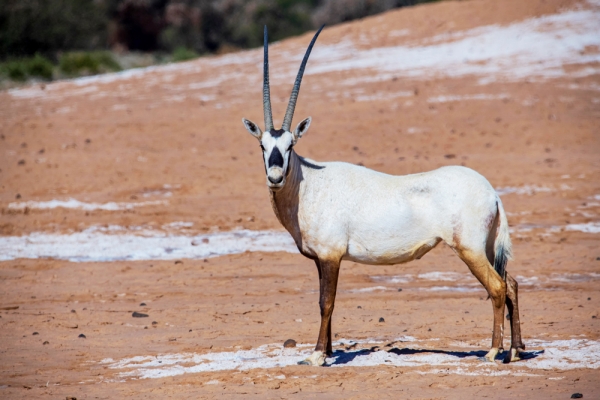


Arabian oryx (Oryx leucoryx), also known as the white oryx, is one of the wild mammal species in the Kingdom of Saudi Arabia. It belongs to the Bovidae family and is originally from the Arabian Peninsula. This species is considered one of the endangered animals, and the Kingdom established centers for its breeding and reintroduction into the wild.
The white oryx is characterized by its predominantly white body, with dark markings on the face and legs. It is also known as 'al-Wadihi,' referring to its white color. The white oryx possesses long, straight, or slightly curved horns, typically thicker and shorter in males than females. It is also characterized by wide hooves that facilitate its movement on sand.
Original habitat of the Arabian oryx
The Arabian Peninsula deserts are the original habitat for the Arabian oryx, especially its northern sides. The Arabian oryx species was on the verge of extinction in the 1960s due to environmental conditions, overhunting, and loss of vegetation cover. However, they were introduced into protected reserves to conserve this species, increase its population, and release them into their original wild habitat to restore ecological balance and enrich biodiversity.
Arabian oryx breeding in Saudi Arabia
The Kingdom has shown keen interest in preserving endangered species. In 1990, it launched a specialized program to breed Arabian oryx in Prince Saud al-Faisal Center for Wildlife Research, established in 1986 within the administrative boundaries of Taif Governorate, starting with a herd of thirty-eight oryxes. Subsequently, the National Center for Wildlife undertook reintroduction programs in protected areas by releasing these animals in groups, while monitoring and observing them to assess the challenges and opportunities they face.
Arabian oryx reintroduction in Saudi Arabia
The reintroduction of Arabian oryx in the Kingdom began within Imam Saud Bin Abdulaziz Royal Reserve (previously Mahazat as-Sayd Protected Area), northeast of Taif Governorate. The nature reserve was fenced in 1989, and domestic livestock were kept away. Between 1990 and 1993, thirty-eight Arabian oryxes from outside the Kingdom and thirty-four Arabian oryxes from Prince Saud al-Faisal Center for Wildlife Research were brought to the Imam Saud Bin Abdulaziz Royal Reserve. They were placed in acclimatization enclosures as a preparatory stage before release to observe each of them adapting to the new environmental conditions. After verifying their adaptation, they were released within the boundaries of the nature reserve.
Monitoring of the herd continued between 1990 and 1992, during which its population increased and dispersed into smaller groups. Since 1995, longitudinal sampling surveying and counting methods have been employed. At that time, the Arabian oryx population was around four hundred heads. Between 1998 and 1999, due to drought conditions, oryx numbers declined to between 350 and four hundred animals. However, the herd population rebounded following rainfall between 2001 and 2002 with the subsequent vegetation growth, reaching approximately five hundred heads.
The reintroduction project also included Uruq Bani Ma'arid Reserve in ar-Rub' al-Khali (Empty Quarter) due to the good vegetation cover in the region's valleys. In 1995, Arabian oryxes and Arabian sand gazelles (Gazella marica) were introduced into the reserve for the first time. A total of 149 oryxes, of which seventy were males and seventy-nine were females, were transported in seventeen groups.
Uruq Bani Ma'arid Reserve adopts modern techniques such as using drones for monitoring and conducting environmental surveys and studies. It also uses renewable energy and adheres to the environmental sanitation controls.
Monitoring cameras installed by Imam Abdulaziz Bin Mohammed Royal Reserve Development Authority have documented the breeding of Arabian oryx in the King Khaled Royal Reserve. The cameras captured new births and an increase in the Arabian oryx population since the initial release in 2021. Moreover, the cameras recorded the birth of Arabian oryx from the second release in 2022.
Imam Turki Bin Abdullah Royal Reserve works to protect, propagate, and preserve the Arabian oryx. In February 2022, several herds were released into the nature reserve as a part of programs to reintroduce endangered species to their natural habitats. The reserve witnessed its first birth of a white oryx in April 2022. In May 2024, the reserve saw eight new births of Arabian oryxes.
Releasing Arabian oryx into the open environment
After an absence of ninety years from its natural habitat, King Salman Bin Abdulaziz Royal Reserve in the Northern Borders Province within the Kingdom witnessed the birth of the first Arabian oryx in June 2022. Previously, in March 2022, the reserve released several white oryxes as a part of programs to reintroduce endangered species into their natural habitats. This release was carried out in cooperation with the King Salman Bin Abdulaziz Royal Reserve Development Authority. In fact, 170 endangered animals were released in al-Tubayq Nature Reserve, affiliated with the King Salman Royal Reserve. Of these, fifty were Arabian oryx, marking the first release of Arabian oryx into an open environment in the northwest of the Kingdom, within the nature reserve that spans 130,700 km.
Furthermore, the National Center for Wildlife, in collaboration with the Royal Commission for AlUla, released eighty-two endangered wildlife species in Gharameel and Wadi Nakhla Reserves on March 27, 2022, including eighteen Arabian oryxes. This was the first time they were released into these reserves. The animals were fitted with collars to facilitate tracking and monitoring their locations and movements, ensuring their natural integration.
NEOM Reserve also released the Arabian oryx in 2022, after nearly one hundred years of absence from the region. This was a part of the first phase of a wildlife reintroduction program involving releasing several wild animals in the nature reserve in cooperation with the National Center for Wildlife.
On November 26, 2023, the National Center for Wildlife, in cooperation with Prince Mohammed Bin Salman Nature Reserve, released eighty-five endangered wildlife species, including twenty Arabian oryx, forty Arabian sand gazelles, six mountain gazelles, six mountain goats (Oreamnos americanus), and rehabilitated birds.
Related quizzes
Related articles

